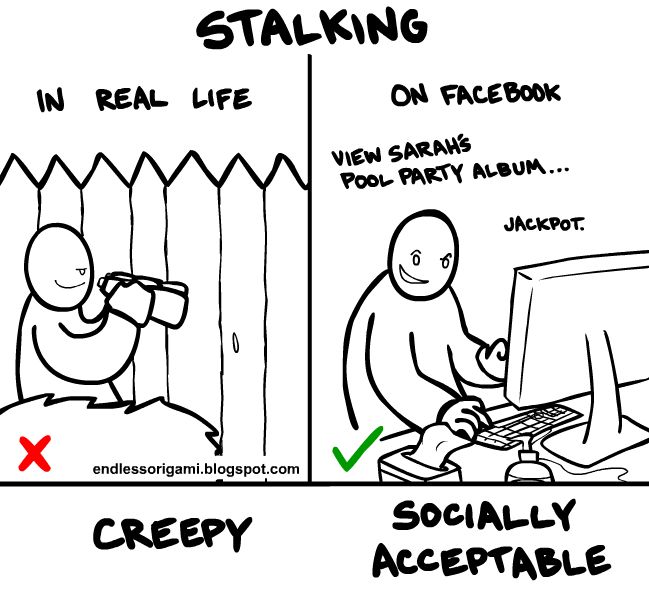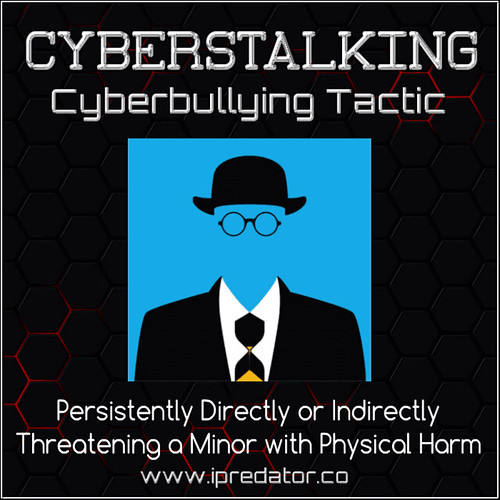
The digital age, with its boundless connectivity and instant communication, has fundamentally reshaped how we interact, share, and perceive relationships. From casual likes to deep conversations, social media platforms have become the virtual town squares of our modern lives. Yet, within this interconnected web, a darker, more insidious phenomenon lurks, often masked by the seemingly innocuous actions of online engagement: social media stalking. We frequently use the term ‘stalking’ playfully with friends, referring to a harmless scroll through their profiles, a common and typically benign activity. However, this casual usage belies the grim reality of actual cyberstalking, a serious crime with potentially devastating outcomes for its targets, demanding a profound understanding of its nuances and psychological underpinnings.
The question then arises: what truly constitutes ‘stalking’ in the digital realm, and at what precise moment does the line blur from innocent social media browsing into genuinely dangerous activity? This inquiry leads us into the complex and often unsettling psychology of a stalker, whose motivations are as diverse as they are deeply rooted. While some might erroneously perceive social media stalking as less severe or threatening than its real-world counterpart, studies unequivocally demonstrate that its repercussions mirror, and sometimes even amplify, the effects of offline stalking. Moreover, the individuals who engage in cyberstalking may harbor underlying mental illnesses that drive these persistent, intrusive behaviors, making a comprehensive exploration of this topic not just informative, but essential for safeguarding our digital spaces.
In this in-depth exploration, guided by an authoritative and analytical lens, we will embark on a journey inside the mind of the social media stalker, dissecting the behaviors, motivations, and psychological factors that transform digital interactions into a pervasive and silent threat. We will move beyond superficial observations, delving into the core mechanisms that enable this form of harassment, from the initial digital probes to the profound impact it leaves on victims. Our goal is to illuminate the often-unseen facets of this digital predator, providing a clearer understanding that is vital for both prevention and intervention in our increasingly online world.

1. **Defining Social Media Stalking: Beyond Casual Browsing** It is crucial to distinguish between the casual, often joked-about act of ‘stalking’ friends’ profiles and the grave reality of actual cyberstalking. While most people on social media might scroll through photos or check updates, a behavior that is usually harmless, true cyberstalking involves a pattern of repeated and unwanted attention, harassment, or contact directed at a specific person that would cause a reasonable individual to feel fear. This distinction is not merely semantic; it delineates between an everyday digital habit and a criminal offense with severe implications. The line is crossed when actions become persistent, intrusive, and evoke a sense of threat or discomfort in the recipient, evolving from simple engagement to a deeply disturbing and potentially dangerous activity.
Jessica Klein, a licensed clinical social worker specializing in trauma, defines stalking as unwanted or obsessive behavior toward an individual intended to frighten or coerce. This can manifest in numerous ways, including bombarding someone with an excessive number of texts, emails, phone calls, or even unwanted gifts. It extends to showing up at a person’s house or workplace uninvited, making explicit or implicit threats, engaging in blackmail, or even escalating to sexual assault. The challenge lies in the seemingly innocent nature of some initial actions – receiving texts or calls, for instance – which only become problematic within the context of repetitive, obsessive, and fear-inducing behavior. This nuanced understanding is essential, as many victims of stalking may not initially realize they are being targeted due to the subtle escalation of these behaviors.

2. **The Widespread Reality: Prevalence and Forms of Cyberstalking** The issue of social media stalking is far more widespread than many realize, permeating the digital lives of a significant portion of the population. According to data from the Pew Research Center, a sobering statistic reveals that nearly one in five Americans has experienced some form of online harassment, a category that explicitly includes cyberstalking. This pervasive nature underscores the urgent need for a deeper public understanding and more robust protective measures. The forms that cyberstalking can take are incredibly diverse, often starting subtly before escalating into more aggressive and intrusive patterns, reflecting the fluid and often unregulated nature of online interactions.
Cyberstalking often commences with seemingly minor, yet unnerving, interactions. This might involve a few unsolicited messages, instances of name-calling, or even the malicious act of leaving false reviews for a victim’s business, designed to inflict reputational or financial harm. Another common initial tactic is to go back through an individual’s online history and ‘like’ an excessive number of their old posts, creating an unsettling digital footprint that signals an unusual level of attention. As the behavior progresses, it can involve a person sending an inordinate volume of messages, some of which may contain inappropriate or sexually explicit content, further invading the victim’s personal space and causing significant distress.

3. **Digital Deception: Understanding Catfishing in Stalking** In the complex landscape of cyberstalking, one particularly deceptive and insidious tactic stands out: ‘catfishing.’ This practice involves a person intentionally pretending to be another individual online, crafting a false identity to interact with their target. The motivations behind catfishing are varied, yet consistently malicious, ranging from a desire to covertly gain personal information or extract money, to building a manipulative ‘relationship’ under false pretenses, or simply aiming to cause profound harm and distress to the victim. It weaponizes trust and emotional vulnerability, turning the digital space into a minefield of deception.
The deceptive nature of catfishing allows perpetrators to operate under a veil of anonymity, making it incredibly difficult for victims to identify their true tormentor. By creating a fabricated persona, the stalker can bypass privacy settings, infiltrate social circles, and gather sensitive data that would otherwise be inaccessible. This digital masquerade enables a deeper level of psychological manipulation, as the victim may invest emotional energy into a relationship with a non-existent individual, only to be betrayed and harmed when the true nature of the interaction is revealed. The emotional toll of such deception can be immense, leading to feelings of profound shame, confusion, and a severe breach of trust, amplifying the already significant trauma of being stalked.

4. **From Screen to Street: When Cyberstalking Extends Offline** While cyberstalking primarily originates and often thrives in the digital realm, its insidious reach frequently extends beyond the confines of screens, manifesting in real-life intrusions that can be terrifying for victims. The ease with which location data can be exploited, coupled with the detailed information often shared online, provides a powerful toolkit for perpetrators to bridge the gap between virtual harassment and physical presence. This escalation from online to offline activity transforms the abstract threat of cyberstalking into a tangible, immediate danger, significantly heightening the victim’s sense of vulnerability and fear.
The modern ubiquity of smartphones and social media features, such as location tags on posts, inadvertently offers stalkers potent means to track their targets. A seemingly innocent shared photo with a geotag can reveal a victim’s favorite coffee shop, workplace, or even home address. Furthermore, some forms of stalking may involve sophisticated GPS tracking, turning a victim’s digital breadcrumbs into a literal map for their harasser. This transition from online surveillance to in-person appearance – whether it’s showing up uninvited at a victim’s home or workplace, or ‘coincidental’ encounters in public places – elevates the stakes considerably, converting psychological distress into a direct threat to personal safety. The fear generated by knowing an online stalker can find you in the physical world is a particularly insidious aspect of this evolving crime.

5. **The Mind’s Labyrinth: Obsessive Behavior as a Stalking Driver** At the very core of stalking behavior, both online and offline, lies a profound and often debilitating element: obsession. It is imperative to acknowledge that there is no singular, archetypal ‘stalker’; rather, stalking is a complex behavior deeply entwined with a multitude of underlying psychological disorders. A pivotal discovery in understanding the psychology of stalking reveals its frequent rootedness in obsessive behavior. This means that the relentless pursuit and harassment stem from an uncontrollable urge, one that is persistent, recurring, and often overwhelms the individual’s capacity for rational thought or self-regulation, manifesting as an all-consuming fixation on their target.
These obsessions are not merely strong interests; they can originate from deeply entrenched delusions, often characteristic of severe psychological disorders. A recurring theme among many stalkers is the false belief that their victims are, in fact, romantically in love with them, a delusion that fuels their persistent advances and misinterprets every interaction. Other individuals may become obsessively fixated on the idea of reclaiming a lost relationship, unable to accept the reality of a breakup and relentlessly pursuing their former partner. Furthermore, obsessions can revolve around a person’s appearance, leading to intense feelings of jealousy or an overwhelming desire to emulate the victim, driving the stalker to monitor and harass them in an effort to satisfy their own distorted psychological needs. This obsessive pursuit profoundly impacts the stalker’s daily life, often to the point where it interferes with work, friendships, and self-care, even as they struggle, sometimes unknowingly, with the implications of their actions.

6. **The Anonymity Paradox: Social Media’s Role in Enabling Stalkers** Social media platforms, while designed for connection, paradoxically offer unique opportunities that enable stalking behaviors, particularly through the perceived veil of anonymity. For many individuals, the idea of being anonymous or semi-anonymous online acts as a significant trigger, loosening inhibitions and fostering behaviors they would ordinarily eschew if their true identities, names, or photos were overtly linked to their actions. This psychological shift, where the consequences of one’s actions feel distant or non-existent, often emboldens individuals to engage in more cruel, aggressive, or harassing conduct than they would ever consider in face-to-face interactions.
Public opinion polls consistently reflect this understanding, with Americans overwhelmingly agreeing that anonymity online enables individuals to act more cruelly or engage in harassment. This dynamic is particularly evident in cases involving ‘trolls’ or aggressive stalking, where the primary intent is to cause deliberate harm, offense, or emotional distress. The lack of immediate, tangible repercussions and the psychological distance provided by a screen can dehumanize the victim in the stalker’s mind, making it easier to justify or detach from the maliciousness of their actions. This digital shield not only facilitates initial acts of harassment but can also contribute to the escalation of stalking behaviors, as perpetrators feel increasingly insulated from accountability.

7. **The Intertwined Web: Mental Health Disorders Fueling Stalking** Delving deeper into social media stalking reveals a critical link to underlying mental health conditions. Obsessive behaviors, characterized by “persistent, repeated, and unwanted thoughts or urges,” extend beyond conditions like obsessive-compulsive disorder. These intrusive patterns often intertwine with a spectrum of mental health issues; anxiety and depression, for instance, frequently contribute to and are exacerbated by obsessive thinking, impairing self-regulation.
Studies also illuminate a connection between obsessive behaviors, stalking, and substance use disorder, showing heightened prevalence among those grappling with addiction. Body dysmorphic disorder, where a person is “overly focused on their weight or how they look,” can fuel obsessions, leading individuals to stalk those they idolize or wish to emulate. Disturbingly, “sexual obsessions,” involving “intrusive thoughts about sexual experiences with strangers, potentially including non-consensual actions and assault,” are identified as potential triggers, highlighting their dangerous nature.
As we continue to unravel the minds behind obsessive pursuit, let’s remember that behind every statistic is a real person whose life has been profoundly affected by stalking. It’s for them – the victims, the survivors, and yes, even the stalkers themselves – that we must continue this important work.



